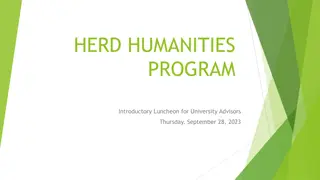Alfred Marshall's Contributions to Economic Analysis
Explore Alfred Marshall's significant contributions to economic thought, including popularizing supply-demand analysis, consumer surplus, and producer surplus. Discover his graphical analyses of two-country trade and offer curves, shedding light on free trade outcomes and terms of trade. Dive into Marshall's pioneering work in shaping modern economic theory.
Download Presentation

Please find below an Image/Link to download the presentation.
The content on the website is provided AS IS for your information and personal use only. It may not be sold, licensed, or shared on other websites without obtaining consent from the author. Download presentation by click this link. If you encounter any issues during the download, it is possible that the publisher has removed the file from their server.
E N D
Presentation Transcript
Alfred Marshall (1842-1924) ECO54 History of Economic Thought Udayan Roy
Alfred Marshall (1842-1924) Principles of Economics, 1890 Free PDF download 2 Alfred Marshall
Sources: Alfred Marshall The Ordinary Business of Life by Roger Backhouse, pages 177- 182 The Worldly Philosophers by Robert L. Heilbroner, Chapter VII (The Victorian World and the Underworld of Economics), pages 205-212 New Ideas from Dead Economists by Todd Buchholz, Chapter VII (Alfred Marshall and the Marginalist Mind) 3 Alfred Marshall
Popularization of Supply-Demand Analysis Marshallian Cross; Marshall popularized the use of the familiar supply-demand diagram Popularization of consumer surplus and producer surplus 4 Alfred Marshall
Reciprocal Demand Graphical analysis of two-country trade 5 Alfred Marshall
Offer Curve: Country A Quantity Imported of Good Y No-trade terms of trade Quantity Imported of Good X Quantity Exported of Good X No trade Quantity Exported of Good Y 6 Alfred Marshall
Offer Curve: Country B Quantity Imported of Good Y Quantity Imported of Good X Quantity Exported of Good X Quantity Exported of Good Y 7 Alfred Marshall
Offer Curve: Country B Quantity Imported of Good Y Quantity Exported of Good X Quantity Imported of Good X Quantity Exported of Good Y 8 Alfred Marshall
Offer Curve: Country B Quantity Exported of Good Y Quantity Exported of Good X Quantity Imported of Good X Quantity Imported of Good Y 9 Alfred Marshall
Free Trade: two-country outcome Good Y: imports of A and exports of B Free Trade terms of trade Offer Curve of Country B. Offer Curve of Country A. Good X: imports of A and exports of B Good X: exports of A and imports of B Good Y: exports of A and imports of B 10 Alfred Marshall
Elasticity of Demand Elasticity of Demand formula, 1882 Marshall also discussed the determinants of the elasticity of demand High price (relative to buyers incomes) Availability of substitutes 11 Alfred Marshall
Elasticity of Supply Supply elasticity depends on time available to producers to respond to a price change Market period: perfectly inelastic supply, price is determined entirely by demand in the case of perishable goods and by expected future prices in the case of durable goods. Short run: rising supply curve, price is determined by both supply and demand, usage levels of some resources are fixed Long run: usage levels of all resources are variable, supply could be a falling curve Very long period: changes in knowledge, population and capital cause long run prices to change gradually 12 Alfred Marshall
Economies of Scale Internal and external economies of scale Internal economies: as a firm expands production, its per-unit costs decline External economies: as an industry expands production, the per-unit costs of production decline for every firm Possibility of a falling supply curve for the industry As an industry expands, per-unit costs may fall as a result of external economies. Therefore, prices may fall. 13 Alfred Marshall
Wages Wages are equal to the marginal product of labor von Thunen and John Bates Clark, an American economist trained in Germany, had said the same thing earlier But Marshall went farther 14 Alfred Marshall
Wages Marshall pointed out that the demand for a resource, such as labor, was a derived demand, because it depended on the demand for the finished goods made by the resource 15 Alfred Marshall
Marshalls four laws of derived demand 1. The greater the substitutability of other resources for labor, the greater the elasticity of demand for labor 2. The greater the price elasticity of product demand, the greater the elasticity of demand for labor 3. The larger the proportion of total production costs accounted for by labor, the greater the elasticity of demand for labor 4. The greater the elasticity of supply of other inputs, the greater the elasticity of demand for labor 16 Alfred Marshall
Interest and Investment In today s macroeconomic theories, it is assumed that business investment spending is inversely related to the interest rate Marshall explained why this is so, relying on diminishing returns to capital Saving, on the other hand, rises with the interest rate The interest rate reaches the level at which investment equals saving 17 Alfred Marshall
Assessment Neo-classical synthesis. The Adam Smith of his age. 18 Alfred Marshall























